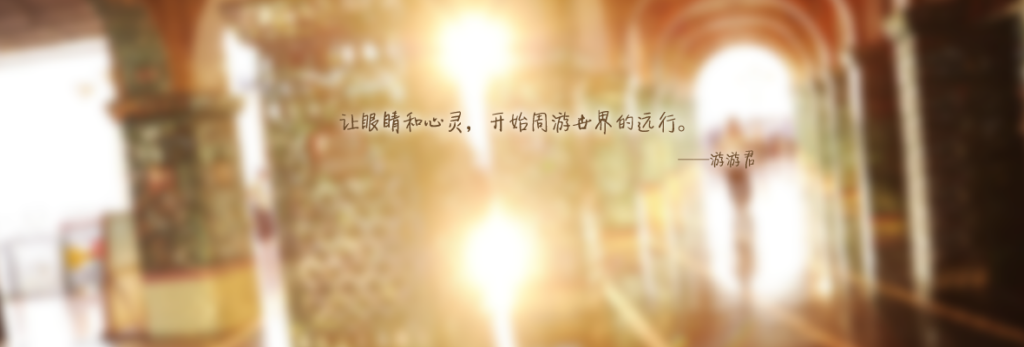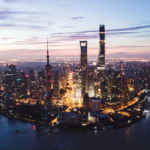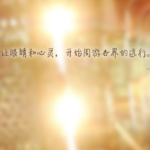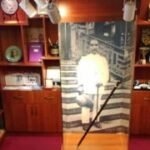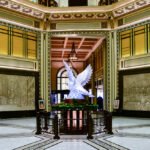Duration: 8 days. Time: November. Per capita cost: 5000 yuan. Companion: Alone. Ways to play: food, photography, humanities, independent travel, train, saving money. The author visited these places: Macau Soong Ching-ling Former Residence Memorial Hall, Zhou Enlai’s Residence (Chongqing CCP Delegation Residence), Sun Yat-sen Former Residence Memorial Hall, Mao Zedong’s Former Residence, Shanghai Natural History Museum, Nanjing Road Pedestrian Street, The Bund, Sun Yat-sen Memorial Hall, People’s Square, Shanghai Museum, Huangpu River, Yuexiu Park, Guangdong Provincial Museum, Canton Tower, Huacheng Square, Sightseeing Tower, Huangpu Military Academy Site Memorial Hall, Seven Star Crags, Dinghu Mountain, Butterfly Valley, Feishuitan, Qingyun Temple, Headquarters of the Macau Special Administrative Region Government, Historic Centre of Macau, Ruins of St. Paul, Macau Peninsula, Taipa Island, Coloane Island, Rua do Cunha, St. Paul’s Church, Maritime Museum, Marine and Water Bureau Building, Mandarin’s House, Guia Theatre, Studio City Macau, A-Ma Temple, Monte Fort, Macau Museum, The Venetian Macao, Studio City Macau, Wynn Macau. The Nanjing Museum of the Six Dynasties, Jiangsu Art Museum, Pilu Temple, Confucius Temple. Posted on December 11, 2020. Macau travelogue. The full name of Macau is the Macau Special Administrative Region. After Macau’s return, the ‘one country, two systems’ is implemented in terms of system. As of this month, Macau has been back to the motherland for exactly 21 years. I have always wanted to go to Macau to take a look on the spot. After making up my mind, I began to research and formulate a travel plan to Macau. I decided to transfer from Shanghai to Guangzhou. On the evening of November 30, I flew from Dalian to Shanghai. I had originally studied the plan to spend a whole day visiting Disneyland Park the next day, but gave up at the last moment. Generally speaking, I am still more interested in humanities, history and natural scenery. December 1 itinerary: Soong Ching-ling Former Residence Memorial Hall, Zhou Enlai’s Residence (Chongqing CCP Delegation Residence), Sun Yat-sen Former Residence Memorial Hall, Mao Zedong’s Former Residence, Shanghai Natural History Museum, Nanjing Road Pedestrian Street, The Bund. After having breakfast, I strolled slowly along the street. I arrived at the Soong Ching-ling Former Residence Memorial Hall at 9 am. The overall specification of this museum is relatively high, the service is good, and the explanations are detailed. After visiting, there is an involuntary sense of respect. The large lawn in front of the main building is very famous. Soong Ching-ling has met many Chinese and foreign guests on this lawn. After leaving the Soong Ching-ling Memorial Hall, walking along the street for more than ten minutes, I arrived at Zhou Enlai’s Residence (Chongqing CCP Delegation Residence). This is the former site of the Shanghai office of the Communist Party of China delegation during the first period of cooperation between the Kuomintang and the Communist Party. Zhou Enlai, Dong Biwu and some other Party leaders once worked and fought here. Because Zhou Enlai was responsible for presiding over daily work, it is also called Zhou Enlai’s Residence. The explanations in the museum are relatively vivid, and one can experience the tense atmosphere of that era. The Sun Yat-sen Former Residence Memorial Hall is very close to Zhou Enlai’s Residence. This is the place where Sun Yat-sen lived in the last ten years of his life. He lived with Soong Ching-ling here for eight years. It is the residence where they lived together for the longest time.
Duration: 8 days. Time: November. Per capita cost: 5000 yuan. With whom: Alone. Ways of playing: food, photography, humanities, independent travel, train, saving money.

The author visited these places: Macau; Soong Ching-ling Former Residence Memorial Hall; Zhou Enlai’s Residence; Sun Yat-sen’s Former Residence Memorial Hall; Mao Zedong’s Former Residence; Shanghai Natural History Museum; Nanjing Road Pedestrian Street; The Bund; Sun Yat-sen Memorial Hall; People’s Square; Shanghai Museum; Huangpu River; Yuexiu Park; Guangdong Provincial Museum; Canton Tower; Huacheng Square; Sightseeing Tower; Huangpu Military Academy Site Memorial Hall; Seven Star Crags; Dinghu Mountain; Butterfly Valley; Feishuitan; Qingyun Temple; Headquarters of the Macau Special Administrative Region Government; Historic Centre of Macau; Ruins of St. Paul; Macau Peninsula; Taipa Island; Coloane Island; Rua do Cunha; St. Paul’s Church; Maritime Museum; Marine Department Building; Casa de Lou Kau Mansion; Guia Chapel; Studio City Macau; A-Ma Temple; Monte Fort; Macau Museum; The Venetian Macao; Studio City Macau; Wynn Macau.
There is an exhibition on some of Sun Yat-sen’s life stories in the museum. Some of Sun Yat-sen’s thoughts and works that influenced the Chinese revolution were born here. Unfortunately, photography is not allowed inside the museum. Not far from the Sun Yat-sen Memorial Hall is the former residence of Mao Zedong. This was the residence where Mao Zedong and Yang Kaihui lived together when he was working in Shanghai in 1924. Mao Zedong had been to Shanghai more than ten times. This is the place where he lived for the longest time. During his work here, Mao Zedong’s leadership and work ability were improved. At the same time, during this period, Mao Zedong had a new and fundamental understanding of the Chinese revolution. He realized that peasants and armed struggles are two basic issues of the Chinese revolution. We must vigorously carry out the peasant movement and create a revolutionary path of encircling the cities from the countryside and seizing political power by armed forces. The formation of these thoughts influenced the entire China later. Leaving the former residence of Mao Zedong, take the subway to People’s Square. Here are the Shanghai Museum and the Shanghai Natural History Museum. I have visited the Shanghai Museum before, so this time I will visit the Shanghai Natural History Museum. It has a large area and many exhibits. I strolled around for more than an hour. After leaving the Shanghai Natural History Museum, it was still early. Looking at the map, I chose to stroll in the direction of Nanjing Road. In the evening, along Nanjing Road Pedestrian Street, I strolled slowly all the way to the Bund. When I arrived at the Bund, the sky was getting dark. Various ships on the Huangpu River were coming and going, presenting a busy scene. Standing on the Bund and looking at the scenery on both sides of the Huangpu River, one can feel the extraordinary charm of Shanghai. According to the scheduled plan, I took a flight from Shanghai to Guangzhou at night. When boarding the plane, I was pleasantly surprised to find that the plane I was taking was a twin-aisle wide-body passenger plane. This is the second time I have taken a twin-aisle wide-body passenger plane. I took it once more than 20 years ago. Time passes so quickly. In a blink of an eye, 20 years have passed. Truly, in an instant. I find that the most ruthless thing in this world is actually time. After arriving in Guangzhou, for convenience of travel, I chose to stay in a hotel opposite Yuexiu Park. The room assigned to me is on the 15th floor. The room is very large and has a large floor-to-ceiling window from which I can overlook the lush Yuexiu Park. The view is very open. When I got up early, I checked the weather forecast. The highest temperature that day was 25 degrees Celsius. It was neither cold nor hot, very suitable for traveling. In contrast, it is said that it has started snowing in Dalian. December 2 itinerary: Guangdong Museum, Canton Tower, and Marshal Sun Yat-sen’s Mansion. In the morning, take the subway to Huacheng Square first. Here are the Guangdong Museum, Guangzhou Grand Theater, and Guangzhou Library. There are many high-rise buildings around. Opposite is the Canton Tower across the river. Looking at the Canton Tower from a distance, it is dignified and graceful, very beautiful. The Guangdong Museum has a square appearance and a large area. It seems to be nicknamed the ‘candy box’. It is a comprehensive exhibition hall integrating nature, humanities and history, astronomy and geography. Among them, the crinoid fossil is one of the treasures of the museum and is the second largest in China.
Encountered a tour group of elderly ladies with southern accents, who listened to the detailed explanations while viewing the exhibits. At the end of the tour, as the guide bid farewell, an elderly lady with glasses earnestly and solemnly began to preach the principles of life to the group, speaking for about 20 minutes. The guide was astonished, nodding in agreement with a mix of embarrassment and politeness. After leaving the Guangdong Museum, I took the subway across the river to reach the Guangzhou Tower. Standing at 600 meters tall, the Guangzhou Tower is currently the tallest tourist attraction in China and the third tallest in the world, known as the new landmark of Guangzhou, colloquially called ‘Xiao Man Yao’. There are several ticket packages for ascending the tower; I purchased a 150 yuan package. Upon reaching the top, the clear weather allowed for a panoramic view of the Pearl River banks and an appreciation of the beautiful scenery of Guangzhou, which was fantastic. After leaving the Guangzhou Tower, I took a bus to visit the Former Residence of the Commander-in-Chief. This site was the location of the headquarters for Sun Yat-sen’s revolutionary government in Guangzhou, providing a detailed understanding of the revolutionary process Sun Yat-sen initiated. Guangzhou is not only economically developed but also a city of gourmet food. In the evening, I found a buffet restaurant and enjoyed a hotpot meal. December 3rd itinerary: Sun Yat-sen Memorial, Sun Yat-sen Memorial Hall, Whampoa Military Academy, Sacred Heart Cathedral, Guangzhou Liberation Monument, Museum of the Mausoleum of the King of Nanyue during the Western Han Dynasty, and the Five Goats Statue. The next morning, I first went to the Guangzhou First People’s Hospital, which is very close to the hotel, a 20-minute walk away. For traveling from mainland China to Macao, a nucleic acid test report within seven days is required. The hospital was crowded, and the test cost was 70 yuan. I remember it cost 105 yuan at the Dalian Central Hospital, a bit more expensive than in Guangzhou. After leaving the hospital, I went to the Whampoa Military Academy. The site is relatively far from the city center, requiring a subway ride, a ferry, and then a ten-minute walk to arrive. The Whampoa Military Academy is a very famous place in modern Chinese history, often mentioned in films and TV series about the resistance and liberation periods. It was an honor for soldiers of that era to study at Whampoa. The academy was founded by both the Kuomintang and the Communist Party during their first cooperation, training a large number of military leaders from both parties, including Ye Jianying, Chen Yi, Chen Geng, Xu Xiangqian, and Lin Biao. Chiang Kai-shek once served as the principal, and Zhou Enlai was the director of the political department. This is the principal’s office where Chiang Kai-shek worked during his tenure. After visiting the Whampoa Military Academy, I took the subway back to the city center and visited the Sacred Heart Cathedral. This church is one of the larger ones in Guangzhou, a popular spot for social media photos, with a Gothic architectural style, entirely built from marble. However, due to the pandemic, it was not open to the public.
Not far from the church stands the Guangzhou Liberation Monument. After visiting, take the subway to the First People’s Hospital of Guangzhou to collect your nucleic acid test report. Leaving the hospital, it’s about a 20-minute walk to the Museum of the Mausoleum of the Nanyue King. This is the location of the tomb of the second-generation Nanyue King, with the tomb chamber open to the public, covering an area of approximately 100 square meters. This was the first time in my life I had the opportunity to visit the interior of an imperial tomb. What struck me was the presence of fifteen burial figures accompanying the Nanyue King; these figures were not in coffins but laid flat throughout the tomb chamber. After more than 2000 years, only the skeleton of the Right Consort could barely be discerned as a few bone fragments, while the rest of the burial figures had vanished into dust, leaving only faint traces of human forms, truly embodying the saying ‘dust to dust, earth to earth.’ Time can indeed destroy everything, no matter how much wealth and glory one might have once possessed. Thus, it is said that money and power will all turn to dust a hundred years later; one should eat, drink, and travel when the desire arises, for that is the true way of life!
Inside the museum, the exhibition displays the funerary objects from the tomb. The artifacts are rich and the unearthed items are exceptionally exquisite. The treasure of the museum is a silk-threaded jade suit, which is not the gold-threaded jade suit commonly seen on Han Dynasty kings. After leaving the Museum of the Nanyue King, as the day grew late, I walked to the opposite Yuexiu Park for a visit. The famous Five Rams Statue is located within Yuexiu Park. The Five Rams Statue is a symbol of Guangzhou, representing the spirit of its people. It is said that over two thousand years ago, five immortals rode on five sheep carrying grain in their mouths and descended upon Guangzhou, bestowing the grain upon the people. Afterward, the sheep turned into stone rams, and from then on, Guangzhou became a land of abundance, earning it the nicknames ‘City of Rams’ and ‘City of Ears.’ December 4th itinerary: Qi Xing Yan Scenic Area and Ding Hu Mountain Scenic Area in Zhaoqing City. Not far from Guangzhou, there is the Qi Xing Yan Scenic Area, a 5A-level tourist attraction. I knew since childhood that Qi Xing Yan was a famous tourist spot in Guangdong, so visiting it was part of my planned itinerary for this trip to Guangzhou. Looking at the map, it is located in Zhaoqing City, about an hour away by inter-city high-speed train, and my hotel is conveniently close to the train station, making travel very easy. I took the high-speed train in the morning to Zhaoqing Station and then a public bus for about 5 minutes to reach the Qi Xing Yan Scenic Area. According to the introduction, Zhaoqing City has two 5A-level scenic areas: Qi Xing Yan Scenic Area and Ding Hu Mountain Scenic Area, collectively known as Xinghu Scenic Area. The two scenic areas are 16 kilometers apart and are connected by a scenic area bus service, with a combined ticket price of 120 yuan. Qi Xing Yan Scenic Area has been a popular tourist destination since the Tang Dynasty. It features typical karst topography, with peaks, lakes, caves, and inscriptions as its main attractions, earning it the title of the First Wonder of Lingnan.After entering the scenic area, first take a cruise ship to visit several main scenic spots. Then take a bamboo raft to closely observe the seven rock peaks. The feeling of enjoying the beautiful scenery on both sides of the river on a bamboo raft is very refreshing! This kind of tree naturally grows in the water. There are many of them in the scenic area. According to the tour guide, the color of the leaves is different throughout the year. This is the reclining Buddha in the scenic area. It is introduced as the second largest natural reclining Buddha in Asia. After taking a close look, it really looks very similar. This is a karst cave in the scenic area. It is not very long. Entering the interior by boat and listening to the boatman’s explanations along the way is quite interesting. Then take the scenic shuttle bus at the entrance of the scenic area and arrive at Dinghu Mountain Scenic Area. Dinghu Mountain Scenic Area was established in 1956. It is China’s first nature reserve. The biggest feature is that there are many varieties of vegetation and it is called a ‘natural oxygen bar’. There is a large tripod weighing 16 tons and a Duan inkstone weighing 2 tons. Both are Guinness World Records. This is the central lake area. There is a ‘heart’-shaped island in the lake. Looking down from the top, it is very beautiful. Downstream of the lake is the Butterfly Valley, also known as Lover’s Valley. The scenery is very beautiful, especially the air is extremely fresh and breathing is very comfortable. The negative ion content here is also the place with the highest measured content currently known in China. This is the Feishuitan Waterfall. The scenery is good. Sun Yat-sen visited Dinghu Mountain three times and swam in this pool with Soong Ching-ling.
Walking for about half an hour along Feishuitan, you will arrive at Qingyun Temple. Sun Yat-sen once visited this temple and left an inscription as a souvenir.
December 5: Gongbei Port, the headquarters of the Macau Special Administrative Region Government, the pedestrian street in the Historic Center of Macau, and the Ruins of St. Paul (a landmark scenic spot in Macau).
After playing in Zhaoqing, I took the high-speed rail to Zhuhai early the next morning. After getting out of Zhuhai Railway Station, there is Gongbei Port next to it. It only takes 2 to 3 minutes to walk there. It is really very convenient.
Before leaving the country, first of all, I bought a 3-day data package (27 yuan). Because the package cannot be used in Macau, only overseas roaming can be used. The data fee will be very expensive. After buying the data package, it will be connected to CTM, a local communication operator in Macau. Just set it up on your mobile phone and you can save a lot of Internet fees. After setting it up, the mobile phone screen immediately changes.
Secondly, prepare the Macau Health Code. I converted from the Guangdong Health Code to the Macau Health Code and automatically attached the negative nucleic acid test information to the Macau Health Code. When crossing the border, there is no need to provide a paper nucleic acid certificate.
Finally, I exchanged 350 Macau patacas (formerly also called Portuguese patacas) for standby. There are many exchange points on both sides of Gongbei Port. I feel that the inland side is more formal. The exchange rate on that day is 100 RMB for 116 Macau patacas and 113 Hong Kong dollars. There are also many exchange points on the Macau side, but they are all street-side small shops. 100 RMB can be exchanged for 118 Macau patacas.
I crossed the border to Macao from Zhuhai at noon, which was probably the peak hour for crossing the border, with a huge crowd of people, just like a tide. When exiting the mainland side, it was a self-service process, but upon entering Macao, as it was my first time, I could only go through the manual process. Contrary to my expectation that the immigration officer would ask questions, they just glanced at me and finished, probably in about 3 seconds. Due to the queue, the entire entry and exit process took about 20 minutes. After entering Macao, I took a bus to the hotel. All bus routes in Macao cost 6 Macao Patacas. While traveling to the hotel along the streets, I noticed that due to the limited land resources, the streets in the old city are very narrow, and even the buses are small and crowded. Being used to the larger buses in the mainland, it was quite an adjustment. Additionally, vehicles in Macao drive on the right side, and traffic flows on the left side of the road, which is the complete opposite of the mainland, and it took me a while to get used to it. Macao is mainly composed of three parts: the Macao Peninsula, Taipa Island, and Coloane Island. Upon studying the map, I found that the city center and most historical and cultural attractions are located on the Macao Peninsula, with the famous Rua da Cunha and several well-known hotels on Taipa Island, while Coloane Island is mainly known for its beaches and scenery. For convenience, I chose a hotel on the Macao Peninsula, which is about a 5-minute walk from the city center, a 10-minute walk from the historical district, a 15-minute walk from the Ruins of St. Paul’s, facing the Macao Tower across the lake, next to the Consulate of Portugal in Macao, and surrounded by a Portuguese villa area, with a very pleasant environment. After all, this is an overseas trip, and I wanted to see how good Macao really is, so I booked a five-star hotel. This is my second time staying in a five-star hotel, and upon entering the room, I found it even came with a mini courtyard, and the room facilities were excellent, far exceeding my expectations, very impressive, I really wanted to stay a few more days. This is the headquarters building of the Macao Special Administrative Region, small and indeed completely different from the style of government buildings in the mainland. After leaving the hotel, it took about 10 minutes to walk to the historical district, where there are many famous historical sites and numerous tourist shops. I had always heard that the pork chop buns in the Hong Kong and Macao regions are quite famous, so while strolling in the historical district, I bought one to try, costing 20 Macao Patacas, quite large, one was enough to make me full. The trash cans in Macao look like this. This is the iconic landmark of Macao: the Ruins of St. Paul’s. Originally, it was the front wall of the Church of St. Paul, which was built in 1604. Due to a fire, the church was destroyed, leaving only the front wall preserved. On my way back to the hotel, I saw a street performance and enjoyed it for over 20 minutes, singing in Portuguese, with a very emotional and cheerful musical style.
Here is a candid shot of Macao’s night view, which, while not quite as spectacular as the Bund’s night scene, is still quite beautiful. On December 6th, the itinerary included the Maritime Museum, the Port Authority Building, Zheng’s Mansion, the Dom Pedro V Theatre, St. Augustine’s Church, the Municipal Affairs Office Building, the St. Dominic’s Church, and the Macau Tower. This is the Port Authority Building, which during the Portuguese occupation, was the barracks for the many Indian police employed by the Portuguese government, featuring Islamic architectural style. This is the Dom Pedro V Theatre, established in 1860, and is the first Western-style theatre in China. This is St. Augustine’s Church, founded in 1591, and is a European Renaissance-style building, serving as the largest gathering place for local congregants. When I arrived at the church, there were already about 300 congregants inside, so I quickly found the only available seat in the last row. Despite the large number of people, the church was exceptionally quiet, even quieter than when the company holds meetings for middle-level cadres. The congregants were all quietly listening to the choir singing hymns one after another, and I heard ‘Hallelujah’ several times. Shortly after the singing ended, everyone suddenly stood up (I quickly followed suit), bowed their heads solemnly, and listened quietly to someone speaking at the front, not in English or Cantonese, but I presume in Portuguese. Suddenly, everyone made the sign of the cross on their chests and chanted ‘Amen’ in unison, then everyone started talking and singing hymns together, and after singing one, they listened quietly to another person speaking, then suddenly they all sang ‘Hallelujah’ repeatedly, with a very pleasant melody. There were also rituals of anointing congregants with holy water and several moments of kneeling in prayer, and the entire process lasted about an hour. I participated fully, listening and praying with everyone, and the atmosphere was very good, making my heart much calmer, which was excellent. This is the Municipal Affairs Office Building, originally the city hall, built in 1784, in Baroque architectural style. This is the St. Dominic’s Church, founded in 1587, also in Baroque architectural style, housing over three hundred precious artifacts. A ceremony was also being held in the church, with a foreign bishop leading the congregants in prayer, and there were about a hundred congregants, mostly foreigners, with the entire ceremony conducted in English. There were also hymn-singing parts during the ceremony, led by a woman singing in English, with a bel canto style, which was very pleasant to listen to, as the ethereal hymns echoed continuously within the church, exuding solemnity and sanctity. At noon, I visited a five-star hotel to taste Macanese cuisine, where the service was excellent, the dishes were diverse and exquisite, and I ate quite a bit, almost to the point of being full. In the afternoon, I took a leisurely stroll along the lake to digest the excessive lunch, and after walking half the way around the lake, I arrived at the Macau Tower by the lake. I ascended the tower to the revolving restaurant at the top, enjoying afternoon tea while taking in the views of Macao. The weather was very clear, and the beautiful scenery of Macao was fully visible.
December 7 itinerary: Rua do Cunha, Military Exhibition Hall of the Chinese People’s Liberation Army Macau Garrison, The Venetian Macao, The Parisian Macao, Studio City Macau, A-Ma Temple, Wynn Fortune Tree, Fortaleza do Monte, Macau Museum.
In the morning, take a bus to Taipa Island for sightseeing. First, arrive at Rua do Cunha, which is Macau’s souvenir pedestrian street. There are various tourist commodities with Macau characteristics for sale. As it is too early, most shops are not open yet. After walking for more than ten minutes from Rua do Cunha, come to the famous Venetian Macao. Inside this hotel, there is an imitation of the Grand Canal in Venice. It is an internet-famous check-in place for tourism in Macau. When coming in, as it is too early, there is almost no one. The gondolas are quietly waiting for the call of the boatman. This is The Parisian Macao. In front of the hotel, there is a scaled-down Eiffel Tower that is exactly the same as the original one in Paris. It is very eye-catching. This is Studio City Macau. In the middle of the hotel is an 8-shaped ferris wheel. It is very unique. After visiting several famous hotels, take a bus back to the Macau Peninsula again. This is A-Ma Temple. It was built in the Ming Dynasty and is the earliest temple in Macau. After leaving A-Ma Temple, go to Wynn Macau in the city center for a stroll. Here is a famous Wynn Fortune Tree. It is inside this big ball. It will rise from the ball on the hour. According to the introduction, the rising scene is quite shocking, gorgeous and dazzling. However, I waited for the hour, but the fortune tree did not rise. I don’t know if it is affected by the epidemic. After leaving Wynn Hotel, walk for more than twenty minutes to reach the Fortaleza do Monte scenic spot. Fortaleza do Monte was built in 1617 and was the center of Macau’s defense system at that time. There are about more than 30 bronze cannons. Originally, after touring Macau, I planned to fly back to Dalian from Zhuhai. But later, I received a notice from the airline that the flight was changed. So I had to transfer in Nanjing and fly back to Dalian. In the afternoon of December 7, return to the mainland through Gongbei Port. Compared with noon, there are very few people in the afternoon. It only takes about ten minutes to cross the border. Before entering the mainland, I specially went to the duty-free shop to take a look. A carton of Chinese cigarettes costs 320 Hong Kong dollars. It is still very cheap. December 8 itinerary: Nanjing Museum of the Six Dynasties, Jiangsu Art Museum, Pilu Temple, Confucius Temple Scenic Area. I have been to Nanjing many times. After flying to Nanjing, take the subway to visit the Nanjing Museum of the Six Dynasties first. The exhibition hall is not very large. It mainly introduces and exhibits the history of the six dynasties. Adjacent to the Nanjing Museum of the Six Dynasties is the Jiangsu Art Museum. There are many paintings inside. I went in and visited. After leaving the art museum, walk for more than ten minutes to reach Pilu Temple. The ginkgo trees here are very famous. It is a bit late. Most of the ginkgo leaves have fallen. It is a scene of withering and incompleteness.In the afternoon, I received a notice from the airline again. The flight to Dalian was delayed until evening. Since there was still plenty of time, I strolled slowly along the street and visited the Confucius Temple scenic area. In the middle of the night, the plane safely arrived in Dalian. As soon as I walked out of the airport, I felt a chill. Looking at the temperature, it was already below zero. Wow, I experienced the feeling of going directly from summer to winter again!! This is the story of my trip to Macau this time. I feel that Macau is still very good and I should be able to visit it again. Thank you for watching!!
